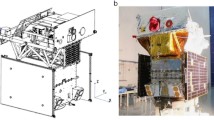Abstract
Plans for the deployment of a comprehensive set of instruments designed to study the high-energy emissions of solar flares have been developed as part of a series of studies for an Advanced Solar Observatory (ASO). These studies have identified the Space Station as the preferred mode for the deployment of the full ASO. The accident of the Space Shuttle Challenger in 1986, and the growth in the estimated costs for the Space Station during the fiscal year 1989 budget discussions, have created an uncertain climate within the United States Space Program, making it difficult to predict the schedule for major programs such as the ASO. Approaches to the deployment of instruments for the study of high-energy solar emissions alone, or in conjunction with other solar instruments are discussed. As an independent entity the High-Energy Facility could be on a co-orbiting platform.
Similar content being viewed by others
References
Astronomy Survey Committee: 1982, Astronomy and Astrophysics for the 1980's, National Academy Press, Washington, D.C., p. 148.
Aviation Week and Space Technology: 1988.
Banks, P. M.: 1981a, AIAA Aerospace Science 25, 87–016.
Banks, P. M.: 1987b, Proc. Int. Astron. Congress 38, 87.
Dennis, B. R.: 1988, ‘Max 91’: Flare Research at the Next Solar Maximum, NASA Technical Report, Goddard Space Flight Center, Greenbelt, MD.
Easterbrook, G.: 1987, Newsweek 46.
Dunn, R. B.: 1981, Space Sci. Rev. 29, 341.
Hudson, H. S. and Lin, R. P.: 1978, Space Sci. Instr. 4, 101.
Illing, R. M. E., Zaun, N. H., and Bybee, R. L.: 1988, Proc. S.P.I.E. (in press).
Jefferies, J. T. et al.: 1974, Scientific Uses of the Space Shuttle, National Academy of Sciences, Washington, D.C., Chapter 7.
Jordan, S. D.: 1981, Space Sci. Rev. 29, 333.
Rogers, W. P. et al.: 1986, Report by the Presidential Commission on the Space Shuttle Challenger Accident, US Govt Printing Office, Washington, D.C.
Space Science Board: 1974, Scientific Uses of the Space Shuttle, National Academy of Sciences, Washington, D.C.
Tandberg-Hanssen, E., Hudson, H. S., Dabbs, J. R., and Baity, W. A. (eds.): 1983, The Pinhole/Occulter Facility, NASA Technical Paper, 2168.
Tandberg-Hanssen, E., Wilson, R. M., and Hudson, H. S. (eds.): 1986, Solar Flares and Coronal Physics Using P/OF as a Research Tool, NASA Conf. Publ. 2421.
Walker, A. B. C., Jr.: 1982, Phys. Today 35, 61.
Walker, A. B. C., Jr.: 1988, Solar Phys. 118, 209 (this issue).
Walker, A. B. C., Jr., Moore, R., and Roberts, W.: 1986, The Advanced Solar Observatory Executive Summary, NASA Technical Report, Marshall Space Flight Center, Huntsville, AL.
Walker, A. B. C., Jr. et al.: 1983, in Challenges to Astronomy and Astrophysics, National Academy Press, Washington, D. C., Chapter 1.
Author information
Authors and Affiliations
Rights and permissions
About this article
Cite this article
Walker, A.B.C., Roberts, W.T. & Dabbs, J.R. High-energy facility development plan. Sol Phys 118, 365–371 (1988). https://doi.org/10.1007/BF00148601
Received:
Issue Date:
DOI: https://doi.org/10.1007/BF00148601




